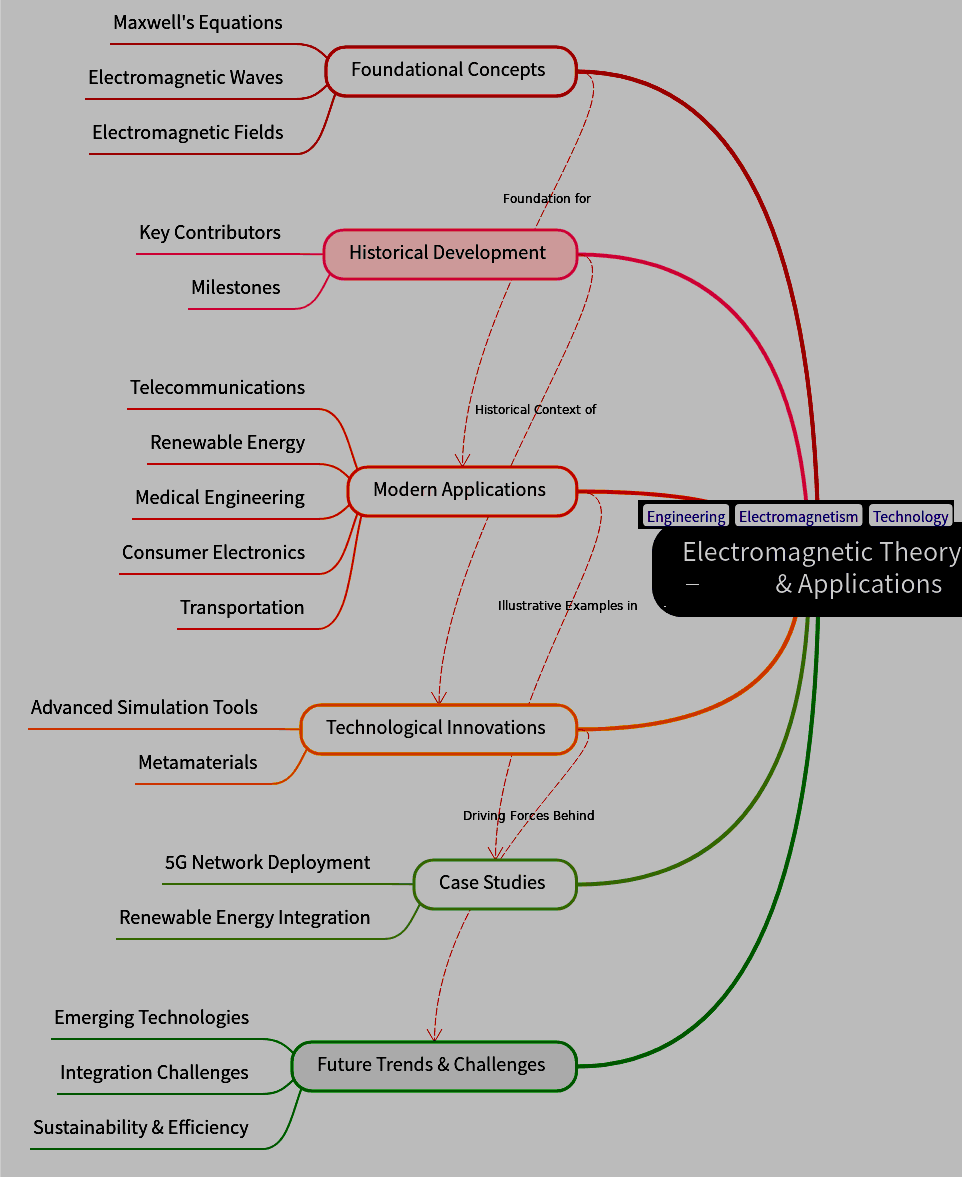
Electromagnetic Theory: Modern Engineering Applications Explained
Electromagnetic theory is a fundamental pillar of modern engineering, underpinning a vast array of technologies that shape our daily lives. From the smartphones we use to the renewable energy systems powering our homes, understanding electromagnetic principles is crucial for innovation and advancement in various engineering fields. This article delves into the core concepts of electromagnetic theory and explores its diverse applications in telecommunications, renewable energy, medical engineering, consumer electronics, and transportation. Additionally, we examine recent technological innovations, real-world case studies, and future trends that highlight the ongoing significance of electromagnetic theory in engineering.
Foundational Concepts of Electromagnetic Theory
Maxwell’s Equations
At the heart of electromagnetic theory lie Maxwell’s equations, a set of four fundamental equations that describe how electric and magnetic fields interact. These equations form the foundation for understanding electromagnetic waves, field theory, and the behavior of electromagnetic fields in different media.
- Gauss’s Law for Electricity: Describes how electric charges produce electric fields.
- Gauss’s Law for Magnetism: States that there are no magnetic monopoles; magnetic field lines are continuous loops.
- Faraday’s Law of Induction: Explains how a changing magnetic field induces an electric field.
- Ampère’s Law (with Maxwell’s addition): Describes how electric currents and changing electric fields produce magnetic fields.

Electromagnetic Waves and Fields
Electromagnetic waves are oscillations of electric and magnetic fields that propagate through space. These waves travel at the speed of light and encompass a wide spectrum, including radio waves, microwaves, infrared, visible light, ultraviolet, X-rays, and gamma rays. Understanding electromagnetic waves is essential for designing communication systems, medical imaging devices, and various other technologies.
Historical Development of Electromagnetic Theory
The development of electromagnetic theory has been marked by significant milestones and contributions from key scientists. From James Clerk Maxwell’s unification of electricity and magnetism to Heinrich Hertz’s experimental validation of electromagnetic waves, the evolution of this theory has paved the way for numerous technological advancements. These historical developments have not only deepened our understanding of electromagnetic phenomena but also enabled practical applications that have transformed society.
Modern Applications of Electromagnetic Theory
Electromagnetic theory is integral to multiple engineering disciplines. Below, we explore its applications across various fields:
Telecommunications
5G Technology
The deployment of 5G networks relies heavily on electromagnetic wave propagation and antenna design. Electromagnetic theory enables the development of high-frequency circuits and advanced signal processing techniques, ensuring faster data transmission and lower latency in communication systems.
Fiber Optics
Fiber optic technology utilizes electromagnetic waves to transmit data over long distances with minimal loss. Understanding the principles of electromagnetic wave propagation and light-matter interaction is essential for optimizing fiber optic cables and enhancing data transmission efficiency.
Renewable Energy
Wind Turbines
Electromagnetic induction is a key principle in the operation of wind turbines. As wind turns the turbine blades, it drives a generator where electromagnetic fields convert mechanical energy into electrical energy, contributing to sustainable energy solutions.
Solar Energy Systems
Photovoltaic cells in solar panels convert sunlight into electricity through the interaction of electromagnetic waves with semiconductor materials. Electromagnetic theory guides the design and optimization of these cells to improve energy conversion efficiency.
Medical Engineering
MRI Technology
Magnetic Resonance Imaging (MRI) employs strong electromagnetic fields and radio waves to create detailed images of the body’s internal structures. Understanding electromagnetic field interactions with biological tissues is crucial for developing safe and effective medical imaging devices.
Medical Imaging Devices
Beyond MRI, various medical imaging technologies, such as ultrasound and X-rays, rely on electromagnetic principles. These devices enhance diagnostic capabilities, enabling accurate detection and treatment of medical conditions.
Consumer Electronics
Smartphones
Smartphones are a prime example of electromagnetic theory in action. Wireless communication, antenna design, and electromagnetic compatibility are essential for ensuring seamless connectivity and device performance.
Wireless Charging
Wireless charging technology uses electromagnetic induction to transfer energy from a charging station to a device without physical connectors. This application simplifies device usage and promotes convenience in everyday life.
Transportation
Electric Vehicles
Electric vehicles (EVs) depend on electromagnetic principles for motor operation and energy storage. Efficient electromagnetic field management enhances motor performance, battery life, and overall vehicle efficiency.
Magnetic Levitation Trains
Maglev trains utilize electromagnetic forces to achieve frictionless movement, enabling high-speed transportation with reduced energy consumption and minimal maintenance requirements.
Technological Innovations in Electromagnetic Engineering
Advanced Simulation Tools
The development of sophisticated electromagnetic simulation tools has revolutionized engineering design processes. These tools allow engineers to model and analyze complex electromagnetic interactions, leading to optimized designs and reduced development times.
Metamaterials and Their Applications
Metamaterials are engineered materials with properties not found in nature, achieved through precise manipulation of electromagnetic wave interactions. Applications of metamaterials include invisibility cloaks, superlenses, and advanced antenna designs, pushing the boundaries of what is technologically possible.
Case Studies: Successful Implementations of Electromagnetic Applications
Case Study 1: 5G Network Deployment
The rollout of 5G networks in urban areas demonstrates the practical application of electromagnetic theory in telecommunications. Advanced antenna designs and efficient electromagnetic wave propagation techniques have enabled higher data rates and improved network reliability, meeting the growing demand for mobile connectivity.
Case Study 2: Renewable Energy Integration
Integrating wind and solar energy systems into the power grid showcases the role of electromagnetic theory in sustainable energy solutions. Efficient energy conversion and transmission, guided by electromagnetic principles, have facilitated the widespread adoption of renewable energy sources, contributing to environmental sustainability.
Future Trends and Challenges in Electromagnetic Engineering
Emerging Technologies
Emerging technologies such as quantum computing and advanced wireless communication systems will continue to rely on electromagnetic theory. Innovations in these areas promise to enhance computational power and communication efficiency, driving further advancements in engineering and technology.
Addressing Integration and Compliance Challenges
As electromagnetic applications become more pervasive, ensuring seamless integration into existing systems and compliance with regulatory standards remains a challenge. Engineers must navigate electromagnetic compatibility standards and adapt to rapid technological changes to maintain system performance and safety.
Conclusion
Electromagnetic theory remains a cornerstone of modern engineering, driving innovations across diverse fields such as telecommunications, renewable energy, medical engineering, consumer electronics, and transportation. By understanding and applying electromagnetic principles, engineers can develop advanced technologies that enhance efficiency, sustainability, and quality of life. As technological advancements continue to evolve, electromagnetic theory will undoubtedly play a pivotal role in shaping the future of engineering and addressing the complex challenges of tomorrow.
References
- Maxwell, J. C. (1865). A Dynamical Theory of the Electromagnetic Field. Philosophical Transactions of the Royal Society of London.
- Hertz, H. (1887). On the Production of Electric Waves with Very Short Wave-Lengths. Annalen der Physik.
- Faraday, M. (1831). Experimental Researches in Electricity. Philosophical Transactions of the Royal Society.
- IEEE Standards Association. (2023). IEEE Standard for Electromagnetic Compatibility (EMC).
- Smith, D. R., & Pendry, J. B. (2004). Metamaterials and Negative Refractive Index. Science.





